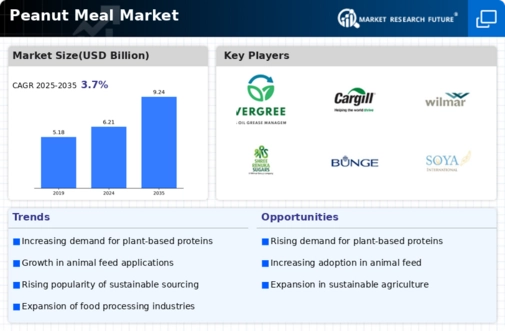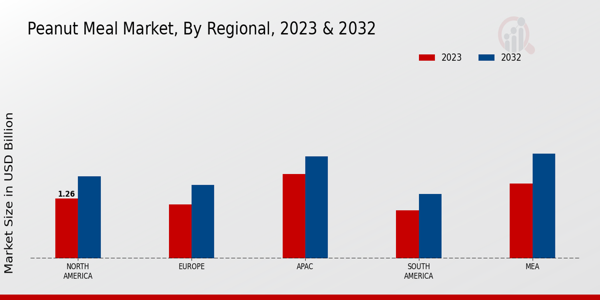Market Growth Projections
The Global Peanut Meal Market Industry is projected to experience substantial growth, with market value expected to reach 9.24 USD Billion by 2035. This growth trajectory suggests a compound annual growth rate (CAGR) of 3.68% from 2025 to 2035. Such projections indicate a robust demand for peanut meal across various sectors, including food, feed, and industrial applications. The anticipated increase in market value reflects the growing recognition of peanut meal as a versatile and nutritious ingredient. As the industry evolves, stakeholders are likely to explore new applications and markets, further driving the expansion of the Global Peanut Meal Market Industry.
Expansion of Animal Feed Sector
The Global Peanut Meal Market Industry benefits from the expansion of the animal feed sector, which increasingly incorporates peanut meal as a cost-effective protein source. The growing livestock industry, particularly in regions such as Asia and Latin America, drives the demand for high-quality feed ingredients. Peanut meal, with its favorable amino acid profile, is particularly valued in swine and poultry diets. This trend is expected to contribute to the market's growth, as the demand for peanut meal in animal feed is projected to rise, further solidifying its position within the Global Peanut Meal Market Industry. The anticipated growth in this sector aligns with the overall market value projected to reach 9.24 USD Billion by 2035.
Emerging Markets and Economic Growth
Emerging markets, particularly in Asia and Africa, present significant opportunities for the Global Peanut Meal Market Industry. Economic growth in these regions is driving increased consumption of protein-rich foods, including peanut meal. As disposable incomes rise, consumers are more inclined to purchase higher-quality food products, which include plant-based protein sources. This trend is further supported by government initiatives promoting sustainable agriculture and food security, which often highlight the benefits of incorporating peanut meal into diets. The Global Peanut Meal Market Industry is likely to capitalize on these developments, as the demand for peanut meal in emerging markets continues to expand.
Rising Demand for Plant-Based Proteins
The Global Peanut Meal Market Industry experiences a notable surge in demand for plant-based proteins, driven by increasing health consciousness among consumers. As more individuals adopt vegetarian and vegan diets, the preference for plant-derived protein sources, such as peanut meal, intensifies. This shift is reflected in the projected market value of 6.21 USD Billion in 2024, indicating a robust growth trajectory. Peanut meal, rich in protein and essential nutrients, serves as an attractive alternative to animal-based protein sources, appealing to a diverse consumer base. Consequently, the Global Peanut Meal Market Industry is likely to expand significantly, catering to this evolving dietary trend.
Technological Advancements in Processing
Technological advancements in processing methods significantly enhance the efficiency and quality of peanut meal production, positively impacting the Global Peanut Meal Market Industry. Innovations such as solvent extraction and mechanical pressing improve oil extraction rates and reduce production costs. These advancements not only increase the yield of peanut meal but also enhance its nutritional profile, making it more appealing to consumers and manufacturers alike. As processing technologies continue to evolve, the market is likely to witness increased competition and improved product offerings, which could further stimulate growth. The Global Peanut Meal Market Industry stands to benefit from these developments, as they align with the projected CAGR of 3.68% for the period from 2025 to 2035.
Growing Awareness of Nutritional Benefits
The Global Peanut Meal Market Industry is experiencing growth due to increasing awareness of the nutritional benefits associated with peanut meal. Rich in protein, fiber, and essential fatty acids, peanut meal is recognized for its potential health benefits, including improved heart health and weight management. As consumers become more informed about the advantages of incorporating peanut meal into their diets, the demand for this product is likely to rise. This trend is particularly evident in health-conscious markets, where peanut meal is increasingly used in various food products and supplements. The growing recognition of its nutritional value positions the Global Peanut Meal Market Industry for sustained growth in the coming years.


















Leave a Comment